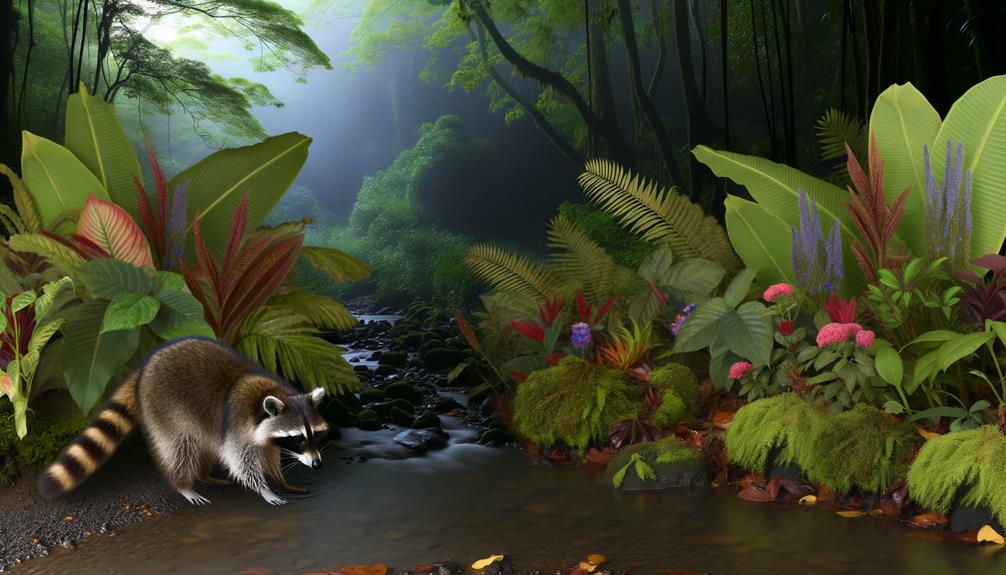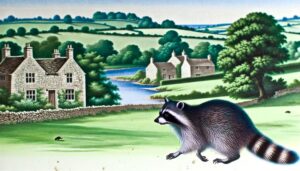There Are Different Types of Raccoons: How to Identify Them
Yes, there are different types of raccoons, each adapted to specific environments. The common raccoon (*Procyon lotor*) inhabits varied habitats and displays a distinctive black facial mask and ringed tail.
The crab-eating raccoon (*Procyon cancrivorus*) is adapted for aquatic environments, with webbed digits aiding its diet of crustaceans. Endemic to Mexico's Cozumel island, the Cozumel raccoon (*Procyon pygmaeus*) is critically endangered.
The Tres Marias raccoon (*Procyon insularis*) is adapted to limited resources on Mexico's Tres Marías Islands. Ultimately, the Guadeloupe raccoon (*Procyon lotor minor*) faces threats from habitat loss.
These raccoon types illustrate the genus's adaptability and evolution.

Key Takeaways
- There are different types of raccoons, each adapted to specific habitats.
- Common raccoons thrive in diverse environments from forests to urban areas.
- Crab-eating raccoons are adapted to aquatic habitats and primarily consume crustaceans.
- Cozumel raccoons are critically endangered and endemic to Cozumel island.
- Tres Marias raccoons have adapted to limited resources on the Tres Marías Islands.
Common Raccoon

The Common Raccoon (Procyon lotor) is a medium-sized mammal native to North America, distinguished by its distinctive black facial mask and ringed tail.
This species exhibits significant adaptability, thriving in diverse habitats ranging from forests to urban areas.
Adult raccoons typically weigh between 5 to 26 lbs (2.3 to 11.8 kg) and have a body length of 16 to 28 inches (40 to 70 cm), excluding the tail.
Their diet is omnivorous, encompassing fruits, nuts, insects, and small vertebrates.
Raccoons display high intelligence, capable of problem-solving and memory retention for extended periods.
They are nocturnal, primarily active during the night, and possess highly dexterous front paws, facilitating their foraging behavior and interaction with the environment.
Crab-Eating Raccoon
Often found in the wetlands and coastal areas of Central and South America, the Crab-Eating Raccoon (Procyon cancrivorus) is a species uniquely adapted to its aquatic environment.
This raccoon exhibits several distinctive characteristics:
- Diet: Primarily consumes crustaceans, particularly crabs, but also feeds on other aquatic organisms like frogs, fish, and insects.
- Morphology: Features webbed digits that facilitate swimming and foraging in water.
- Habitat: Prefers habitats near water bodies, such as mangroves, marshes, and riverbanks.
These adaptations allow the Crab-Eating Raccoon to thrive in environments that other raccoon species may find challenging. Understanding these specific traits provides insight into the ecological niche and survival strategies of Procyon cancrivorus.
Cozumel Raccoon

Distinct from its crab-eating cousin, the Cozumel Raccoon (Procyon pygmaeus) is an endangered species endemic to the island of Cozumel off the Yucatán Peninsula in Mexico.
Characterized by its smaller size, the Cozumel Raccoon typically measures between 30 to 50 centimeters in body length. Its distinguishing features include a more pronounced facial mask and a shorter, bushier tail compared to other raccoon species.
The species inhabits mangrove forests and dense tropical environments, relying heavily on a diet of fruits, insects, and small vertebrates.
The Cozumel Raccoon faces significant threats from habitat loss, human encroachment, and introduced species, leading to its classification as critically endangered by the International Union for Conservation of Nature (IUCN).
Tres Marias Raccoon
Endemic to the Tres Marías Islands off the coast of Nayarit, Mexico, the Tres Marias Raccoon (Procyon insularis) is a subspecies of raccoon that exhibits unique adaptations to its insular environment. This raccoon is characterized by a smaller body size and a narrower skull compared to its mainland relatives, adaptations likely driven by resource limitations on the islands.
Key features include:
- Distinctive Morphology: Smaller body and narrow skull facilitate survival in limited-resource environments.
- Behavioral Adaptations: Altered foraging habits tailored to island-specific food sources.
- Genetic Divergence: Genetic isolation has resulted in significant differentiation from mainland raccoon populations.
These adaptations highlight the influence of insular environments on the evolution of mammalian species.
Guadeloupe Raccoon

The Guadeloupe Raccoon is a subspecies of the common raccoon, primarily found in the Guadeloupe archipelago in the Caribbean.
This raccoon exhibits distinct physical characteristics such as a smaller stature and lighter fur compared to its mainland counterparts.
Currently, the Guadeloupe Raccoon is classified as endangered, with habitat loss and human activity posing significant threats to its survival.
Habitat and Range
Occupying the island of Guadeloupe, the Guadeloupe Raccoon (Procyon minor) primarily inhabits mangrove forests, coastal areas, and lowland tropical forests. These distinct habitats provide essential resources for their survival, including shelter and food sources.
The raccoons exhibit specific preferences within these environments:
- Mangrove Forests: These areas offer protection and abundant food, including crustaceans and fruits.
- Coastal Areas: Proximity to water bodies guarantees access to diverse aquatic prey.
- Lowland Tropical Forests: Rich biodiversity in these forests supports varied foraging opportunities.
The Guadeloupe Raccoon's restricted range to this island underscores its ecological specialization and vulnerability to habitat disturbances. Conservation efforts must prioritize these unique environments to sustain the species' population and ecological role.
Physical Characteristics
Understanding the unique habitat preferences of the Guadeloupe Raccoon provides a foundation for examining its physical characteristics, which exhibit several distinct adaptations to this environment.
The Guadeloupe Raccoon (Procyon minor) is generally smaller than its mainland relatives, with a body length ranging from 40 to 50 centimeters and a weight between 2 and 4 kilograms. Its fur is coarser and denser, likely an adaptation to the humid, tropical climate of the Guadeloupe archipelago.
The facial mask is more pronounced, aiding in nocturnal vision. Additionally, the claws are slightly more curved and robust, facilitating climbing and foraging in the island's diverse vegetation.
These physical traits underscore the raccoon's evolutionary responses to its insular habitat.
Conservation Status
Listed as critically endangered by the International Union for Conservation of Nature (IUCN), the Guadeloupe Raccoon faces significant threats from habitat loss, invasive species, and human activities. This raccoon species, endemic to the islands of Guadeloupe, suffers from the fragmentation of its natural habitat due to urban development and agricultural expansion. Additionally, the introduction of non-native predators and competitors has exacerbated pressures on its population. Human activities such as hunting and vehicle collisions further compound these challenges.
Key conservation efforts include:
- Habitat Restoration: Initiatives to restore and protect the raccoon's natural habitats.
- Invasive Species Management: Programs to control or eradicate non-native species.
- Public Education: Campaigns to increase local awareness and reduce human-related threats.
These measures aim to stabilize and enhance the Guadeloupe Raccoon population.
Raccoon Dog
The raccoon dog (Nyctereutes procyonoides), despite its name, is not a true raccoon but shares some morphological similarities, including a distinctive facial mask.
Native to East Asia, it has also been introduced to parts of Europe, where it inhabits a variety of ecosystems ranging from forests to wetlands.
Its unique physical characteristics and adaptability to different habitats have significant ecological implications.
Unique Physical Characteristics
Raccoon dogs, also known as *Nyctereutes procyonoides*, possess a distinctive dense fur that provides insulation against cold climates and sets them apart from other raccoon species.
Their unique physical characteristics include:
- Facial Mask: Raccoon dogs have a black facial mask resembling that of North American raccoons, though they are not closely related.
- Short Limbs and Tail: Unlike other raccoons, raccoon dogs have shorter limbs and a bushy tail, aiding in maneuverability through dense vegetation.
- Seasonal Fur Changes: Their fur undergoes seasonal changes, becoming thicker and longer during winter to retain heat, and shedding in summer for cooling.
These traits not only provide survival advantages but also contribute to their distinct appearance.
Habitat and Distribution
Primarily found in East Asia, raccoon dogs inhabit a range of environments including forests, grasslands, and wetlands, demonstrating their adaptability to diverse ecological niches.
They are native to countries such as Japan, China, and Korea. These mesocarnivores thrive in deciduous and mixed woodlands, often establishing dens in dense underbrush or natural cavities. Their presence in grasslands and wetlands indicates a flexible diet that includes small mammals, birds, amphibians, and plant matter.
Additionally, raccoon dogs have been introduced to parts of Europe, where they have successfully established populations. This wide distribution underscores their ecological plasticity and resilience, enabling them to occupy various habitats despite regional climatic differences and human-induced environmental changes.
Conclusion
In examining the various types of raccoons, it becomes evident that each subspecies, from the ubiquitous common raccoon to the more specialized Cozumel and Tres Marias raccoons, exhibits unique adaptations and ecological niches.
The crab-eating raccoon, Guadeloupe raccoon, and raccoon dog further illustrate this diversity. Understanding these differences not only enriches our comprehension of Procyonidae but also highlights the intricate balance within ecosystems.
Such knowledge is paramount for informed conservation efforts and fostering a harmonious coexistence with these remarkable creatures.






